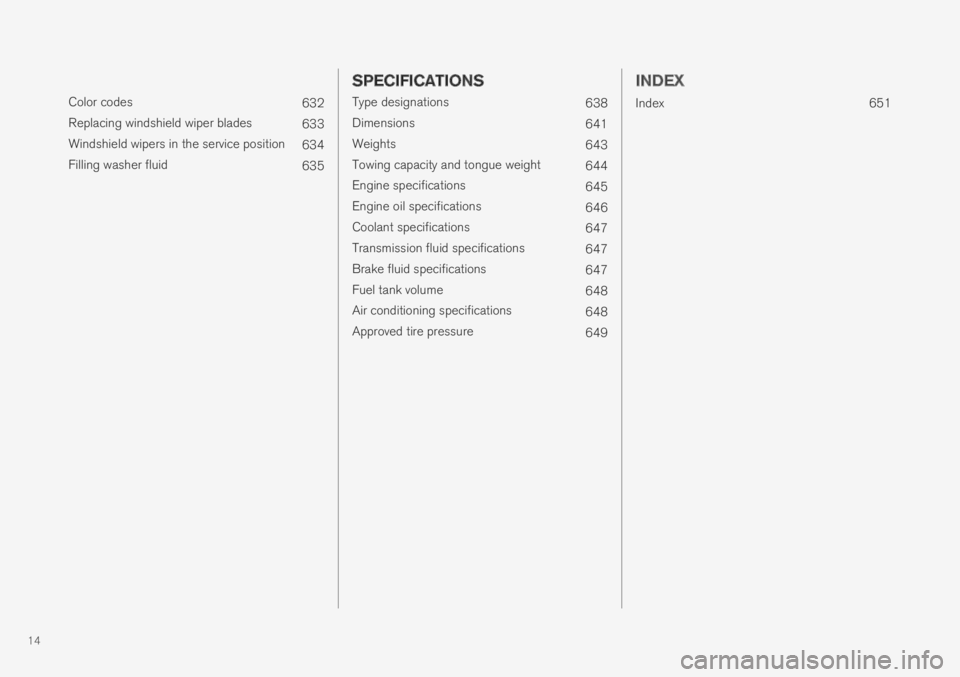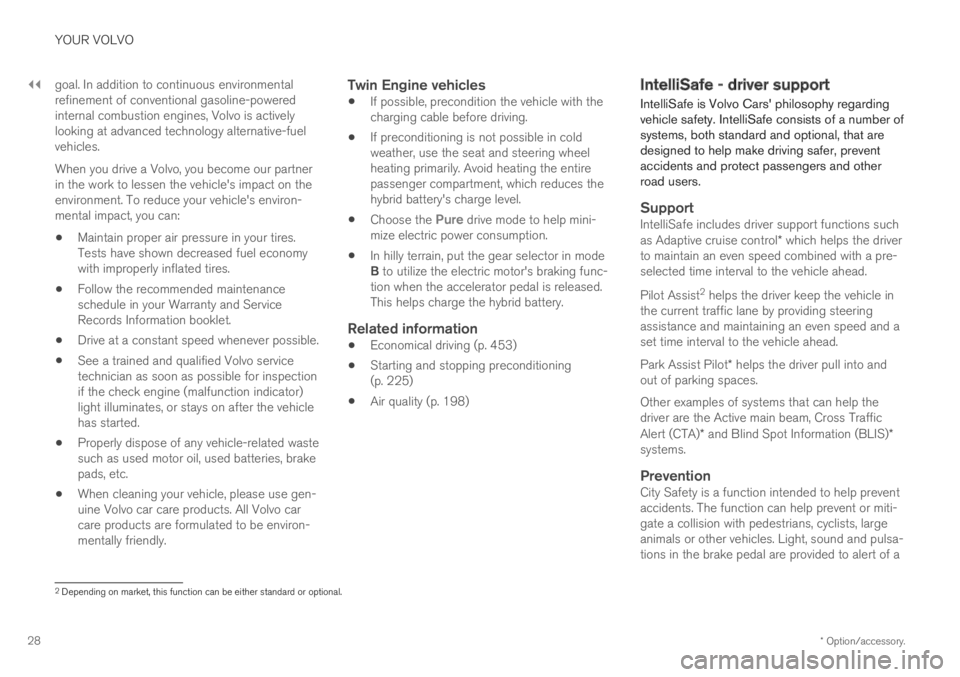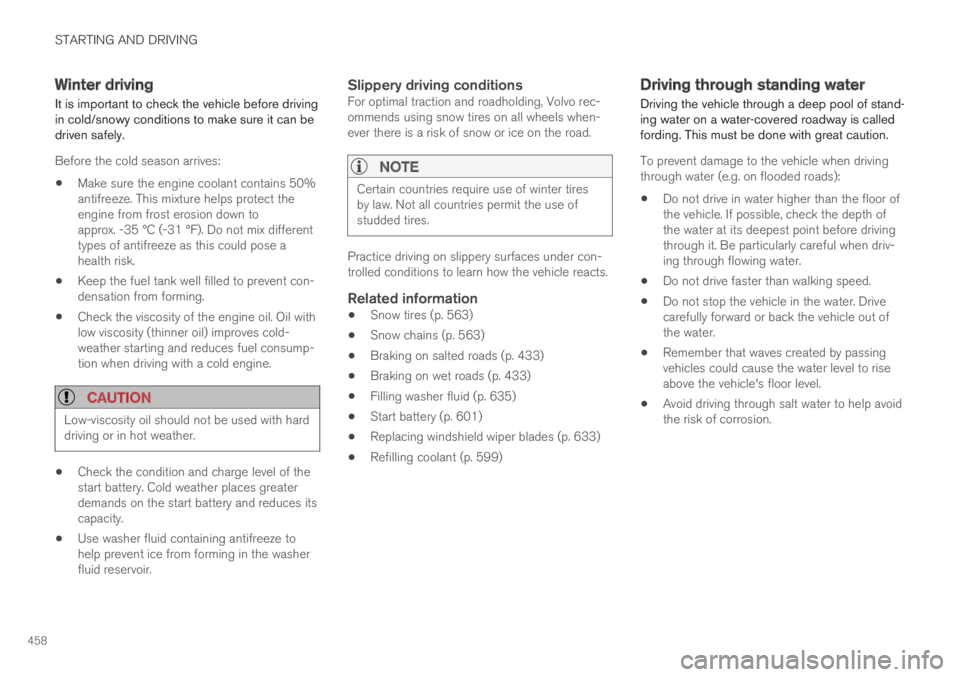oil VOLVO S90 TWIN ENGINE 2019 Owners Manual
[x] Cancel search | Manufacturer: VOLVO, Model Year: 2019, Model line: S90 TWIN ENGINE, Model: VOLVO S90 TWIN ENGINE 2019Pages: 669, PDF Size: 14.33 MB
Page 15 of 669

13
LOADING, STORAGE AND
PASSENGER COMPARTMENT
Passenger compartment interior574
Tunnel console575
Electrical outlets575
Using the electrical outlets576
Using the glove compartment577
Sun visors578
Folding down the armrest in the rearseat*579
Cargo compartment579
Loading recommendations580
Roof loads and load carriers581
Grocery bag holders581
Load anchoring eyelets582
Rear seat ski hatch*582
MAINTENANCE AND SERVICE
Volvo's service program584
Data transfer between vehicle andworkshop over Wi-Fi586
Download Center587
Handling system updates via Down-load Center587
Vehicle status588
Scheduling service and repairs589
Sending vehicle information to theworkshop590
Hoisting the vehicle592
Opening and closing the hood594
Climate control system service595
Replacing a windshield with head-updisplay*595
Engine compartment overview596
Engine oil597
Checking and filling engine oil598
Refilling coolant599
Replacing bulbs600
Start battery601
Hybrid battery605
Battery symbols606
Fuses and fuseboxes606
Replacing fuses607
Fuses in the engine compartment608
Fuses under the glove compartment612
Fuses in the trunk615
Cleaning the interior619
Cleaning the center display619
Cleaning the head-up display*620
Cleaning fabric upholstery and ceil-ing liner621
Cleaning the seat belt621
Cleaning floor mats and inlay mats621
Cleaning leather upholstery622
Cleaning the leather steering wheel623
Cleaning interior plastic, metal andwood surfaces624
Cleaning the exterior624
Polishing and waxing625
Hand washing625
Automatic car washes627
High-pressure washing628
Cleaning the wiper blades628
Cleaning exterior plastic, rubber andtrim components629
Cleaning rims630
Corrosion protection630
Paintwork631
Touching up minor paint damage631
Page 16 of 669

14
Color codes632
Replacing windshield wiper blades633
Windshield wipers in the service position634
Filling washer fluid635
SPECIFICATIONS
Type designations638
Dimensions641
Weights643
Towing capacity and tongue weight644
Engine specifications645
Engine oil specifications646
Coolant specifications647
Transmission fluid specifications647
Brake fluid specifications647
Fuel tank volume648
Air conditioning specifications648
Approved tire pressure649
INDEX
Index651
Page 25 of 669

OWNER'S INFORMATION
23
Information
White ISO symbols and white text/image on ablack message field.
NOTE
The decals shown in the Owner's Manual donot claim to be exact reproductions of thosefound in the vehicle. The purpose is to showapproximately how they look and about wherethey are located. The information that appliesfor your vehicle in particular is found on thedecal on the vehicle.
Procedures
Procedures that must be carried out in a certainorder are shown as numbered lists in theOwner's Manual.
When a series of illustrations are providedalong with the step-by-step instructions, the
numbers of the steps correspond with thenumbers of the illustrations.
Lists using letters instead of numbers areused in cases where the order in which theinstructions are carried out is not important.
Arrows with or without numbers are used toindicate the direction of movement.
Arrows with letters are used to indicate amovement in cases where the order in whichthe instructions are carried out is not impor-tant.
If there are no illustrations associated with step-by-step instructions, the steps are indicated byordinary numbers.
Position lists
Red circles containing a number are used ingeneral overview illustrations of components.The corresponding number is used in theposition list's description of that component.
Bullet lists
Bullets are used for items (components, func-tions, information, etc.) that can be listed in a ran-dom order.
For example:
Coolant
Engine oil
Related information
Related information offers references to otherparts of the manual containing information asso-ciated with the information you are currentlyreading.
Illustrations, images and video clips
Illustrations, images and video clips used in theOwner's Manual are sometimes generic and areintended to provide an overview or an example ofa certain function or feature. They may varydepending on equipment level and market andmay differ from the appearance of your vehicle.
Continues on next page
}} This symbol is shown in the lower right-handcorner to indicate that the current topic continueson the next page.
Continuation from previous page
|| This symbol is shown in the upper left-handcorner to indicate that the current topic is a con-tinuation from the previous page.
Related information
Owner's Manual in the center display (p. 17)
Owner's manual in mobile devices (p. 20)
Volvo Cars support site (p. 21)
Page 30 of 669

||
YOUR VOLVO
* Option/accessory.28
goal. In addition to continuous environmentalrefinement of conventional gasoline-poweredinternal combustion engines, Volvo is activelylooking at advanced technology alternative-fuelvehicles.
When you drive a Volvo, you become our partnerin the work to lessen the vehicle's impact on theenvironment. To reduce your vehicle's environ-mental impact, you can:
Maintain proper air pressure in your tires.Tests have shown decreased fuel economywith improperly inflated tires.
Follow the recommended maintenanceschedule in your Warranty and ServiceRecords Information booklet.
Drive at a constant speed whenever possible.
See a trained and qualified Volvo servicetechnician as soon as possible for inspectionif the check engine (malfunction indicator)light illuminates, or stays on after the vehiclehas started.
Properly dispose of any vehicle-related wastesuch as used motor oil, used batteries, brakepads, etc.
When cleaning your vehicle, please use gen-uine Volvo car care products. All Volvo carcare products are formulated to be environ-mentally friendly.
Twin Engine vehicles
If possible, precondition the vehicle with thecharging cable before driving.
If preconditioning is not possible in coldweather, use the seat and steering wheelheating primarily. Avoid heating the entirepassenger compartment, which reduces thehybrid battery's charge level.
Choose the Pure drive mode to help mini-mize electric power consumption.
In hilly terrain, put the gear selector in modeB to utilize the electric motor's braking func-tion when the accelerator pedal is released.This helps charge the hybrid battery.
Related information
Economical driving (p. 453)
Starting and stopping preconditioning(p. 225)
Air quality (p. 198)
IntelliSafe - driver support
IntelliSafe is Volvo Cars' philosophy regardingvehicle safety. IntelliSafe consists of a number ofsystems, both standard and optional, that aredesigned to help make driving safer, preventaccidents and protect passengers and otherroad users.
Support
IntelliSafe includes driver support functions suchas Adaptive cruise control* which helps the driverto maintain an even speed combined with a pre-selected time interval to the vehicle ahead.
Pilot Assist2 helps the driver keep the vehicle inthe current traffic lane by providing steeringassistance and maintaining an even speed and aset time interval to the vehicle ahead.
Park Assist Pilot* helps the driver pull into andout of parking spaces.
Other examples of systems that can help thedriver are the Active main beam, Cross TrafficAlert (CTA)* and Blind Spot Information (BLIS)*systems.
Prevention
City Safety is a function intended to help preventaccidents. The function can help prevent or miti-gate a collision with pedestrians, cyclists, largeanimals or other vehicles. Light, sound and pulsa-tions in the brake pedal are provided to alert of a
2Depending on market, this function can be either standard or optional.
Page 95 of 669

DISPLAYS AND VOICE CONTROL
93
Warning symbols in the instrumentpanel
The warning symbols alert the driver that animportant function is activated or that a seriousfault or error has occurred.
Symbol Meaning
WARNING
The red warning symbol illuminatesto indicate that a fault has beendetected that could affect safetyand/or driveability. An explanatorymessage will be simultaneouslydisplayed in the instrument panel.The warning symbol may also illu-minate in combination with othersymbols.
Seat belt reminder
This symbol will glow steadily orflash if the driver or front seat pas-senger has not fastened their seatbelt or if anyone in the rear seathas removed their seat belt.
Symbol Meaning
Airbags
If this symbol remains illuminatedor comes on while driving, a faulthas been detected in one of thevehicle's safety systems. Read themessage in the instrument panel.Volvo recommends contacting anauthorized Volvo workshop.
A
B
Fault in brake system
If this symbol illuminates, the brakefluid level may be too low. Contactyour nearest authorized workshopto have the brake fluid levelchecked and adjusted.
A
B
Parking brake on
This symbol glows steadily whenthe parking brake is applied.
A flashing symbol indicates that afault has occurred. Read the mes-sage in the instrument panel.
Symbol Meaning
Low oil pressure
If this symbol illuminates while driv-ing, the engine oil level is too low.Stop the engine immediately andcheck the engine oil level. Add oil ifnecessary. If the symbol illuminatesand the oil level is normal, contacta workshop. Volvo recommendscontacting an authorized Volvoworkshop.
Generator not charging
This symbol illuminates during driv-ing if a fault is detected in the elec-trical system. Contact a workshop.Volvo recommends contacting anauthorized Volvo workshop.
Collision risk
City Safety warns the driver if thereis a risk of a collision with anothervehicle, pedestrian, cyclist or largeanimal.
ACanadian models.BUS models.
Related information
Indicator symbols in the instrument panel(p. 90)
Instrument panel (p. 80)
Page 152 of 669

LIGHTING
150
Parking lights
The parking lights can be used to help otherroad users see the vehicle if it is stopped orparked. Use the lighting ring on the steeringwheel lever to turn on the parking lights.
Lighting ring in the parking light position.
Turn the lighting ring to the position toturn on the parking lights (the license plate light-ing will also illuminate).
Canadian models: If the ignition is in the II posi-tion, the daytime running lights will illuminateinstead of the front parking lights. With the light-ing ring in this position, the parking lights willremain on regardless of what position the ignitionis in.
US models: When mode is selected, thedaytime running lights can be deactivated in thecenter display. The parking lights will also be
deactivated. In weak daylight or dark conditions,the parking lights and low beams will be illumi-nated.
In dark conditions, the rear parking lights alsoilluminate when the trunk lid is opened to alertfollowing traffic. This happens regardless of whatposition the lighting ring or ignition is in.
Related information
Lighting panel and controls (p. 148)
Ignition modes (p. 429)
Daytime running lights
The vehicle has sensors that detect ambientlighting conditions. With the lighting ring in the
position, the daytime running lights willalways be activated when the ignition is in modeII. In weak daylight or dark conditions, the head-lights automatically switch to low beams.
Lighting ring in AUTO position.
Page 430 of 669

||
STARTING AND DRIVING
428
CAUTION
When starting in cold weather, the auto-matic transmission may shift up at slightlyhigher engine speeds than normal untilthe automatic transmission fluid reachesnormal operating temperature.
Do not race a cold engine immediatelyafter starting. This could prevent fluidsfrom properly lubricating vital compo-nents in the engine before it has reachedthe proper operating temperature.
The engine should be idling when thegear selector is moved. Never accelerateuntil the gear is fully engaged. Accelerat-ing rapidly before a gear is properlyengaged could lead to harder wear ofcomponents.
To help prevent the transmission oil fromoverheating, select P or N when idling ata standstill for prolonged periods of time.
Related information
Switching off the vehicle (p. 428)
Ignition modes (p. 429)
Adjusting the steering wheel (p. 193)
Jump starting using another battery (p. 466)
Selecting ignition mode (p. 430)
Switching off the vehicle
The vehicle can be switched off using the startknob in the tunnel console.
Start knob in the tunnel console.
To switch off the vehicle:
–Turn the start knob clockwise and release toswitch off the vehicle. The control will auto-matically return to the original position.
If the vehicle rolls:
–Turn clockwise and hold the knob until thevehicle switches off.
Related information
Starting the vehicle (p. 426)
Ignition modes (p. 429)
Adjusting the steering wheel (p. 193)
Jump starting using another battery (p. 466)
Selecting ignition mode (p. 430)
Page 459 of 669

STARTING AND DRIVING
457
Charge
Engine charges hybridbattery.
This function charges thehybrid battery with the help ofthe combustion engine forincreased use of the electricmotor at a later time.
Symbols in the instrument panel
The symbol is displayed in the hybrid battery gaugewhen Hold is activated.
The symbol is displayed in the hybrid battery gaugewhen Charge is activated.
Related information
Using the electric motor only (p. 454)
Economical driving (p. 453)
Hybrid gauge (p. 83)
Preparing for a long trip
It is important to have the vehicle's systems andequipment checked carefully before driving longdistances.
Check that:
the engine is running properly and that fuelconsumption is normal
there are no leaks (fuel, oil or other fluid)
the brake pedal is functioning optimally
all lights are working ‒ adjust the headlightheight if the vehicle is carrying a heavy load
tire tread depth and air pressure are at cor-rect levels. Change to snow tires when driv-ing in areas where there is a risk of snowy oricy roads
the start battery is sufficiently charged
the wiper blades are in good condition
Related information
Checking tire pressure (p. 549)
Filling washer fluid (p. 635)
Winter driving (p. 458)
Economical driving (p. 453)
Vehicle modem settings (p. 527)
Loading recommendations (p. 580)
Pilot Assist (p. 308)
Speed limiter (p. 275)
Tire sealing system (p. 564)
Page 460 of 669

STARTING AND DRIVING
458
Winter driving
It is important to check the vehicle before drivingin cold/snowy conditions to make sure it can bedriven safely.
Before the cold season arrives:
Make sure the engine coolant contains 50%antifreeze. This mixture helps protect theengine from frost erosion down toapprox. -35 °C (-31 °F). Do not mix differenttypes of antifreeze as this could pose ahealth risk.
Keep the fuel tank well filled to prevent con-densation from forming.
Check the viscosity of the engine oil. Oil withlow viscosity (thinner oil) improves cold-weather starting and reduces fuel consump-tion when driving with a cold engine.
CAUTION
Low-viscosity oil should not be used with harddriving or in hot weather.
Check the condition and charge level of thestart battery. Cold weather places greaterdemands on the start battery and reduces itscapacity.
Use washer fluid containing antifreeze tohelp prevent ice from forming in the washerfluid reservoir.
Slippery driving conditions
For optimal traction and roadholding, Volvo rec-ommends using snow tires on all wheels when-ever there is a risk of snow or ice on the road.
NOTE
Certain countries require use of winter tiresby law. Not all countries permit the use ofstudded tires.
Practice driving on slippery surfaces under con-trolled conditions to learn how the vehicle reacts.
Related information
Snow tires (p. 563)
Snow chains (p. 563)
Braking on salted roads (p. 433)
Braking on wet roads (p. 433)
Filling washer fluid (p. 635)
Start battery (p. 601)
Replacing windshield wiper blades (p. 633)
Refilling coolant (p. 599)
Driving through standing water
Driving the vehicle through a deep pool of stand-ing water on a water-covered roadway is calledfording. This must be done with great caution.
To prevent damage to the vehicle when drivingthrough water (e.g. on flooded roads):
Do not drive in water higher than the floor ofthe vehicle. If possible, check the depth ofthe water at its deepest point before drivingthrough it. Be particularly careful when driv-ing through flowing water.
Do not drive faster than walking speed.
Do not stop the vehicle in the water. Drivecarefully forward or back the vehicle out ofthe water.
Remember that waves created by passingvehicles could cause the water level to riseabove the vehicle's floor level.
Avoid driving through salt water to help avoidthe risk of corrosion.
Page 461 of 669

STARTING AND DRIVING
}}
459
CAUTION
Parts of the vehicle (e.g. engine, transmission,driveline, electrical components, etc.) can bedamaged if the vehicle is driven through waterhigher than its floor level. Damage to anycomponents caused by flooding, vapor lock orinsufficient oil is not covered under warranty.
If the engine stalls while the vehicle is inwater, do not attempt to restart it. Have thevehicle towed on the bed of a tow truck to aworkshop - an authorized Volvo workshop isrecommended.
CAUTION
Because it can be difficult to determine thewater depth, avoid driving through standing orrunning water.
When you have passed the water, press lightly onthe brake pedal and check that the brakes arefunctioning properly. Water, mud, slush, etc. canmake the brake linings slippery, resulting indelayed braking effect.
If the vehicle is equipped with a trailer couplingcontact, clean the contact after driving in water ormud.
Related information
Recovery (p. 470)
Opening/closing the fuel filler door
A button on the instrument panel is used tounlock the fuel filler door.
An arrow next to the fuel pumpsymbol in the instrument panelindicates the side of the vehicleon which the fuel filler door islocated.
1. Press the button on the dashboard.
> Pressure equalization in the fuel tank cau-ses a slight delay before the fuel fillerdoor opens. Fuel tank Fuel lid isopening will be displayed in the instru-ment panel, followed by Fuel tank Readyfor refueling.